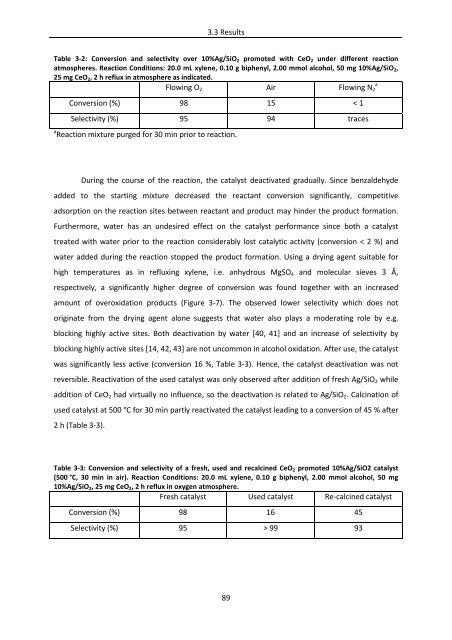Heterogeneously Catalyzed Oxidation Reactions Using ... - CHEC
Heterogeneously Catalyzed Oxidation Reactions Using ... - CHEC
Heterogeneously Catalyzed Oxidation Reactions Using ... - CHEC
Create successful ePaper yourself
Turn your PDF publications into a flip-book with our unique Google optimized e-Paper software.
3.3 Results<br />
Table 3‐2: Conversion and selectivity over 10%Ag/SiO2 promoted with CeO2 under different reaction<br />
atmospheres. Reaction Conditions: 20.0 mL xylene, 0.10 g biphenyl, 2.00 mmol alcohol, 50 mg 10%Ag/SiO2,<br />
25 mg CeO2, 2 h reflux in atmosphere as indicated.<br />
Flowing O2 Air Flowing N2 a<br />
Conversion (%) 98 15 < 1<br />
Selectivity (%) 95 94 traces<br />
a Reaction mixture purged for 30 min prior to reaction.<br />
During the course of the reaction, the catalyst deactivated gradually. Since benzaldehyde<br />
added to the starting mixture decreased the reactant conversion significantly, competitive<br />
adsorption on the reaction sites between reactant and product may hinder the product formation.<br />
Furthermore, water has an undesired effect on the catalyst performance since both a catalyst<br />
treated with water prior to the reaction considerably lost catalytic activity (conversion < 2 %) and<br />
water added during the reaction stopped the product formation. <strong>Using</strong> a drying agent suitable for<br />
high temperatures as in refluxing xylene, i.e. anhydrous MgSO4 and molecular sieves 3 Å,<br />
respectively, a significantly higher degree of conversion was found together with an increased<br />
amount of overoxidation products (Figure 3‐7). The observed lower selectivity which does not<br />
originate from the drying agent alone suggests that water also plays a moderating role by e.g.<br />
blocking highly active sites. Both deactivation by water [40, 41] and an increase of selectivity by<br />
blocking highly active sites [14, 42, 43] are not uncommon in alcohol oxidation. After use, the catalyst<br />
was significantly less active (conversion 16 %, Table 3‐3). Hence, the catalyst deactivation was not<br />
reversible. Reactivation of the used catalyst was only observed after addition of fresh Ag/SiO2 while<br />
addition of CeO2 had virtually no influence, so the deactivation is related to Ag/SiO2. Calcination of<br />
used catalyst at 500 °C for 30 min partly reactivated the catalyst leading to a conversion of 45 % after<br />
2 h (Table 3‐3).<br />
Table 3‐3: Conversion and selectivity of a fresh, used and recalcined CeO2 promoted 10%Ag/SiO2 catalyst<br />
(500 °C, 30 min in air). Reaction Conditions: 20.0 mL xylene, 0.10 g biphenyl, 2.00 mmol alcohol, 50 mg<br />
10%Ag/SiO2, 25 mg CeO2, 2 h reflux in oxygen atmosphere.<br />
Fresh catalyst Used catalyst Re‐calcined catalyst<br />
Conversion (%) 98 16 45<br />
Selectivity (%) 95 > 99 93<br />
89



